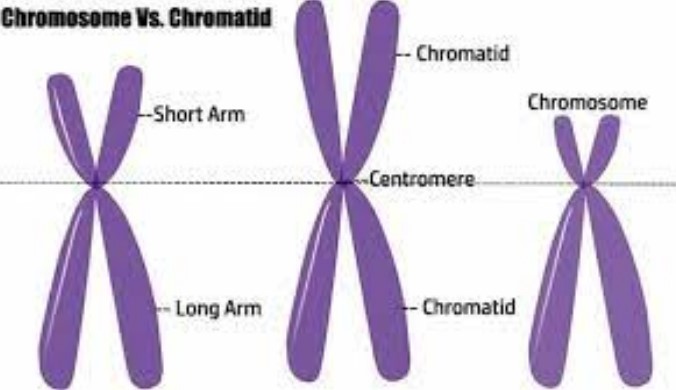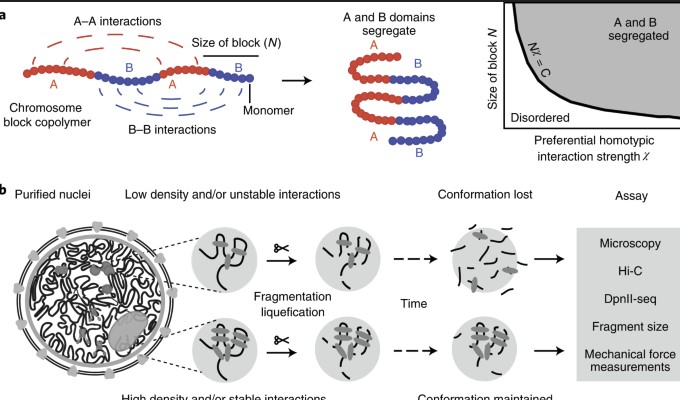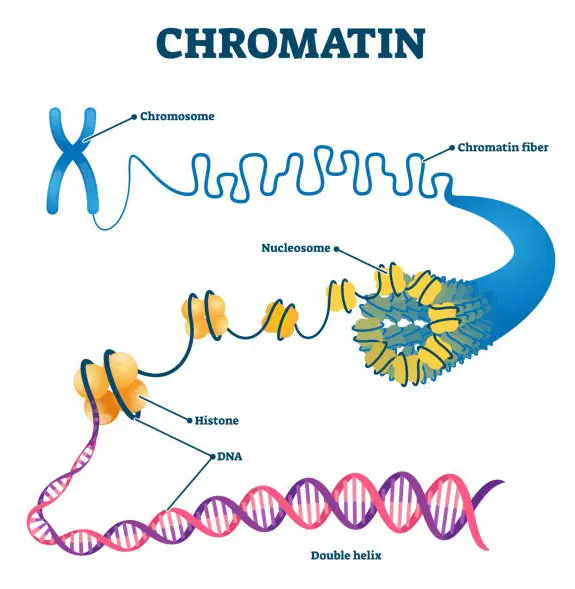Within every cell of our body lies a complex world, bustling with activity at the microscopic level. Central to this microscopic world are two fundamental structures: chromatin and chromosomes. These elements not only house our genetic blueprint but also play critical roles in how our genes are expressed and how our cells divide. This introductory exploration sheds light on the intricate relationship between chromatin and chromosomes, foundational pillars of genetics.
Chromatin is a substance within a chromosome consisting of DNA and protein. It condenses to form chromosomes during cell division, acting as the material in which genes are embedded. The primary relationship between chromatin and chromosomes lies in their structural transformation: chromatin’s complex of DNA and proteins (histones) condenses to form the distinct, tightly packed structures known as chromosomes, essential for the accurate distribution of genetic information during cell division.
The study of chromatin and chromosomes transcends basic biology, influencing fields from genetics to medicine. By understanding their relationship, scientists unlock mysteries of genetic expression, hereditary diseases, and the fundamental processes of life itself. This comprehension not only deepens our grasp of biological complexities but also paves the way for advancements in genetic therapies and personalized medicine, showcasing the significance of these genetic structures in both health and disease.

Basics of Chromatin
Definition and Composition
Chromatin is the complex of DNA and proteins that forms the chromosomes within the nucleus of eukaryotic cells. Its primary components are DNA, histone proteins, and non-histone proteins. DNA carries the cell’s genetic instructions, while histone proteins help package the DNA into a more compact structure. This packaging is essential for DNA stability and regulation of gene expression.
Role in Gene Expression
Chromatin plays a pivotal role in regulating gene expression. Its structure can either expose or hide certain genes from the cellular machinery that reads DNA sequences, effectively turning genes on or off. This regulation is critical for the proper functioning of cells and the development of an organism. Modifications to the structure of chromatin, such as the addition or removal of chemical groups to histones, can influence gene activity.
Chromatin Types
There are mainly two types of chromatin: euchromatin and heterochromatin.
- Euchromatin is less compact and generally associated with active genes. It allows easy access for the machinery involved in transcription.
- Heterochromatin is more densely packed, often found in regions of DNA that are not being transcribed. This type can be further divided into constitutive heterochromatin, which is permanently inactivated, and facultative heterochromatin, which can switch between active and inactive states.
Chromosomes Unveiled
Definition and Structure
Chromosomes are long, thread-like structures made of DNA and associated proteins that carry genetic information. Each chromosome is composed of two identical sister chromatids joined at a point called the centromere. The DNA in chromosomes is further organized and wrapped around histone proteins, forming a structure known as a nucleosome.
Chromosome Numbers in Different Species
The number of chromosomes varies significantly among different species. For instance, humans have 46 chromosomes in each cell’s nucleus, arranged in 23 pairs. Other species, like fruit flies, have only 8 chromosomes, while certain types of ferns can have over 1,200. This variation does not necessarily correlate with the complexity of the organism.
Function in Cell Division
Chromosomes ensure that DNA is accurately copied and distributed in the process of cell division. During mitosis, chromosomes are duplicated and divided evenly between two daughter cells, maintaining genetic consistency. In meiosis, which leads to the production of gametes, chromosome numbers are halved, resulting in genetic diversity among offspring.
From Chromatin to Chromosomes
The Transformation Process
The transformation from chromatin to chromosomes occurs as a cell prepares to divide. Chromatin fibers condense and coil into the distinct shapes known as chromosomes. This process involves multiple steps, including the folding of DNA around histones, further coiling into a solenoid structure, and eventual supercoiling to form the familiar X-shaped chromosome visible under a microscope during cell division.
Role of Chromatin in Forming Chromosomes
Chromatin’s role is critical in forming chromosomes. Its dynamic structure facilitates the condensation of DNA, ensuring that chromosomes are compact enough to be segregated between daughter cells during cell division. Without the proper organization and condensation provided by chromatin, the precise distribution of genetic material during cell division would be jeopardized.
Significance in Mitosis and Meiosis
In mitosis, the significance of the chromatin-to-chromosome transformation lies in ensuring each daughter cell receives an exact copy of the genetic material. In meiosis, this transformation is crucial for genetic recombination and reduction, leading to the genetic diversity essential for evolution and species survival. The structure and modifications of chromatin play pivotal roles in these processes, influencing genetic stability and variability.

Chromatin Modifications
Types of Chromatin Modifications
Chromatin modifications involve changes to the DNA and histone proteins that influence chromatin’s structure and function. The primary types include methylation, acetylation, phosphorylation, and ubiquitination.
- Methylation of DNA and histones can either activate or repress gene expression, depending on the location and context.
- Acetylation of histones generally leads to a more open chromatin structure, facilitating gene expression.
- Phosphorylation and ubiquitination of histone proteins are involved in DNA repair, gene expression, and chromatin condensation during cell division.
Impact on Genetic Functions
These modifications impact genetic functions by regulating access to DNA. For instance, acetylation enhances the binding of transcription factors and other proteins necessary for gene expression, while methylation can create a binding site for proteins that repress transcription. Such dynamic regulation allows cells to respond to internal and external signals swiftly, enabling processes like cell differentiation and adaptation to environmental changes.
Link to Chromosome Structure
The modifications of chromatin directly influence chromosome structure by altering the physical packing of DNA. During cell division, specific modifications help in the condensation of chromatin into chromosomes, ensuring proper segregation. Conversely, during interphase, different modifications keep the chromatin in a less condensed state, allowing for active gene transcription.
Genetic Packaging
Importance of DNA Packaging
DNA packaging is crucial because it condenses the cell’s vast genome into the limited space of the nucleus. This packaging must be highly efficient yet flexible enough to allow access to genes when needed. Without such organization, DNA would be too entangled and voluminous to function effectively within cells.
Chromatin’s Role in Packaging
Chromatin is the cornerstone of DNA packaging, transforming meters-long DNA strands into a compact structure that fits within the microscopic nucleus. This compaction is achieved through the wrapping of DNA around histone octamers, forming nucleosomes, the basic units of chromatin.
Consequences for Cell Function
The level of chromatin compaction has profound consequences for cell function, affecting gene expression, DNA replication, and repair. Highly compacted chromatin, or heterochromatin, is generally transcriptionally inactive, while less compacted chromatin, or euchromatin, is active. This dynamic regulation ensures that genes are expressed at the right time and place.
Regulation of Gene Expression
Chromatin’s Influence on Genes
Chromatin influences gene expression by controlling the accessibility of DNA to transcription machinery. Modifications to chromatin can either expose or conceal genetic regions, thereby facilitating or hindering the transcription of genes.
Mechanisms of Regulation
Mechanisms of chromatin regulation include the aforementioned modifications (methylation, acetylation, etc.), chromatin remodeling complexes that reposition nucleosomes, and non-coding RNAs that can target specific chromatin areas for modification. Together, these mechanisms allow for the precise control of gene activity across different cell types and conditions.
Chromosomes and Gene Accessibility
The structure of chromosomes, dictated by the underlying chromatin, plays a vital role in gene accessibility. For example, genes located in euchromatic regions are more likely to be expressed, while those in heterochromatic regions are often silenced. The positioning of genes within the 3D space of the nucleus also influences their expression levels.
Chromatin, Chromosomes, and Health
Genetic Disorders Linked to Chromatin Structure
Disruptions in chromatin structure and function can lead to various genetic disorders. For instance, aberrant DNA methylation patterns are associated with cancers, and mutations in genes encoding histone-modifying enzymes can lead to developmental disorders. Such disorders underscore the importance of proper chromatin regulation for health.
Chromosomal Abnormalities and Diseases
Beyond chromatin structure, chromosomal abnormalities such as deletions, duplications, and translocations can result in diseases. For example, Down syndrome results from an extra copy of chromosome 21. These abnormalities can disrupt gene function and expression, leading to disease.
Advances in Chromatin Research for Therapy
Research into chromatin biology has led to novel therapies targeting the epigenetic modifications of chromatin. Drugs that inhibit enzymes responsible for aberrant DNA methylation or histone modifications are being developed and tested for various cancers and genetic diseases. This research holds promise for personalized medicine, offering treatments tailored to the specific genetic and epigenetic profiles of individual patients’ conditions.
Frequently Asked Questions
How Does Chromatin Structure Affect Gene Expression?
The structure of chromatin plays a crucial role in regulating gene expression. By undergoing changes in its configuration, chromatin can either expose certain genes to the cellular machinery, making them active, or conceal them, rendering them inactive. This dynamic structure acts as a sophisticated system of gene regulation, influencing everything from cell differentiation to the response to environmental stimuli.
What Causes Chromosomal Abnormalities?
Chromosomal abnormalities can arise from various factors, including errors in meiosis or mitosis, exposure to certain chemicals or radiation, and some viral infections. These errors can lead to the presence of an extra chromosome, the loss of a chromosome, or structural changes within chromosomes, which can disrupt normal development and lead to genetic disorders.
How Are Chromatin and Chromosomes Studied?
Scientists study chromatin and chromosomes through a variety of techniques, including microscopy for direct observation, chromatin immunoprecipitation (ChIP) to study protein interactions and modifications, and sequencing technologies to analyze genetic material. These methods allow researchers to uncover the intricate details of chromatin structure, chromosome dynamics, and their roles in gene regulation and cellular function.
What Role Do Histones Play in Chromatin Structure?
Histones are core proteins around which DNA winds, forming a complex called nucleosomes. These nucleosomes fold and compact to constitute chromatin. Histones play a critical role in chromatin structure by controlling the accessibility of genetic information. They are subject to various chemical modifications that can either relax or tighten their hold on DNA, thus regulating gene expression by making certain genes more or less accessible for transcription.
Conclusion
The relationship between chromatin and chromosomes is a cornerstone of our understanding of genetics and cellular biology. Through the dynamic interplay of these structures, cells orchestrate the complex processes of gene expression and cell division, ensuring that genetic information is accurately maintained and passed on. This deep dive into their relationship not only illuminates the intricate workings of our cells but also highlights the importance of ongoing research in unraveling the mysteries of life at the molecular level.
As we continue to uncover the nuances of chromatin and chromosome function, we unlock potential pathways for treating genetic diseases, understanding evolutionary biology, and advancing personalized medicine. The journey of discovery in the realms of chromatin and chromosomes is far from over; it promises to yield insights that could revolutionize our approach to health, disease, and understanding the very fabric of life itself.

